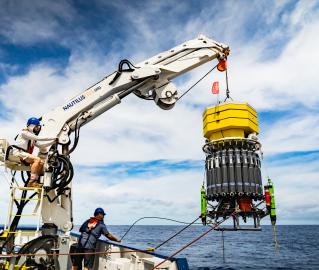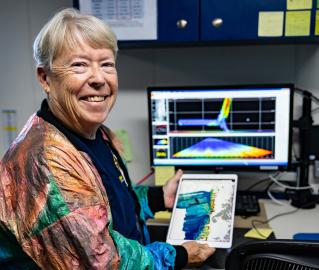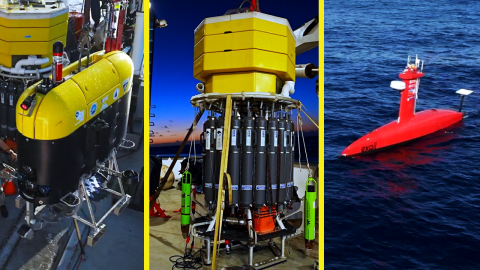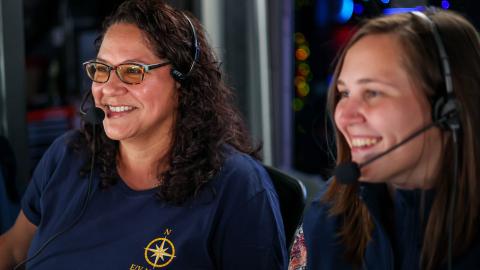OECI Collaboration to Test Technology for Science and Exploration
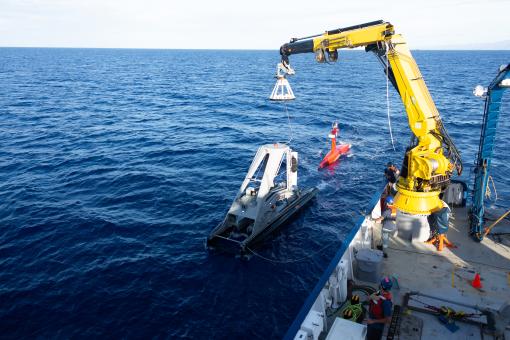
On October 1, Ocean Exploration Trust (OET) and partners set sail from Honolulu aboard E/V Nautilus for a technological collaboration expedition in Hawai’i waters. OET will host three different autonomous and remotely operated platforms on the ship to keep bounding ahead strategies for deploying multiple underwater vehicles in tandem to advance efficiencies and force multipliers in ocean exploration. Last year’s technological collaboration aboard E/V Nautilus, NA139, tested how these ocean exploration tools could work together for science. This year, we’ll be pushing the limits on collaboration by exploring seamounts and the water column around the Geologist Seamounts located south of the Main Hawaiian Islands in a way no single autonomous technology could do alone.
The technologies included in this year’s collaboration expedition are the University of New Hampshire’s uncrewed surface vehicle (USV) DriX, the University of Rhode Island’s Deep Autonomous Profiler (DAP) Lander, and Woods Hole Oceanographic Institution’s hybrid remotely-operated vehicle (HROV) Mesobot, as well as new autonomous eDNA samplers with in situ filtration that will be mounted on the DAP and Mesobot. This expedition is funded by NOAA Ocean Exploration via the Ocean Exploration Cooperative Institute (OECI).
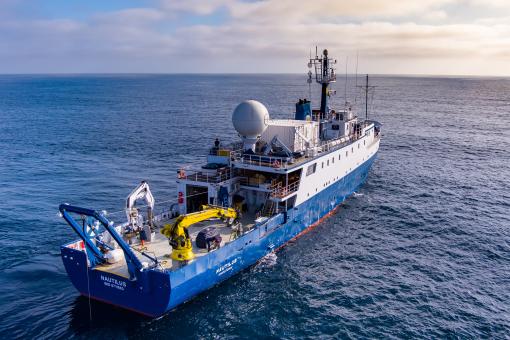
“NOAA Ocean Exploration is committed to pushing technology in order to expand our baseline knowledge in the amazing locations we are funded to explore,” says Expedition Leader Jason Fahy, Associate Director of Ocean Exploration Cooperative Institute. “Through the OECI, they supported our concept to use multiple autonomous systems to explore the seabed, water column, and surface simultaneously. This year, we operationalize this capability with an expedition dedicated to understanding the Geologist Seamounts.”
Over the last three years, OET and OECI have integrated emerging exploration technologies to enhance ocean exploration. This third annual iteration of technology demonstrations will be an 18-day telepresence-enabled expedition that combines deployments of USV DriX, HROV Mesobot, and DAP Lander, each of which offers complementary capabilities to explore the ocean from the seafloor through the entire water column.
“Fifty percent of the U.S.’s exclusive economic zone is not yet mapped, and- while progress is being made to both map and characterize these waters- the pace of this exploration remains somewhat slow,” says Dr. Aurora Elmore, NOAA Ocean Exploration. “We need to expand our use of new technologies, especially those that can work together to increase the pace of exploration so that we can better understand and protect the deep sea. ”
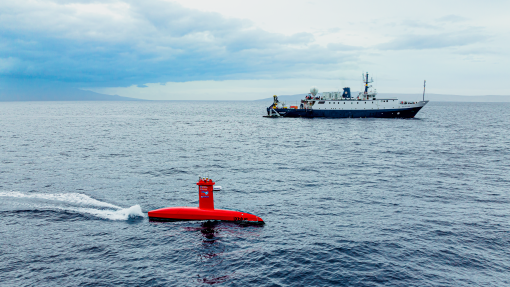
Returning from last year’s technology collaboration is the Center for Coastal and Ocean Mapping/Joint Hydrographic Center at the University of New Hampshire’s USV DriX. DriX is a 7.7 meter-long USV outfitted with multibeam sonars capable of mapping seafloor and imaging the midwater, topside sensors for situational awareness, and various communication systems to act as a relay shuttling data to surface ships and vehicles below the sea surface.
E/V Nautilus will also again host Woods Hole Oceanographic Institution’s HROV Mesobot - a vehicle designed to study poorly understood midwater environments. The team will use Mesobot’s systems to observe and sample portions of the water column with the highest abundances of pelagic biota, also known as deep scattering layers, to characterize the region with cameras and an eDNA sampler.
A particular focus of this expedition will be to use DriX’s EK80 sonar to understand better the midwater environment above seamounts, which are difficult to explore and host high abundances of pelagic organisms. Ideally, DriX’s communication tools will direct HROV Mesobot and the DAP Lander for targeted sampling in these areas.
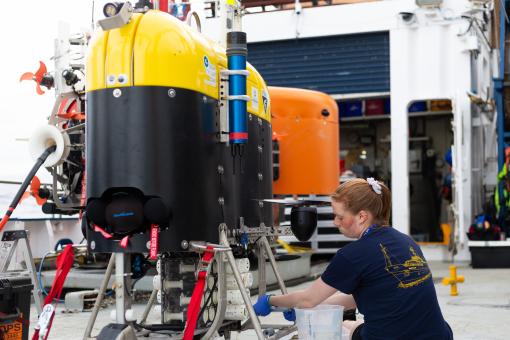
“The ability to use DriX to ‘see’ exactly where Mesobot is with respect to targets in the water column and direct sampling has opened up a new world that removes many of the uncertainties normally associated with understanding where the samples come from,” says Larry Mayer, Lead Scientist and Director, School of Marine Science and Ocean Engineering & Center for Coastal and Ocean Mapping, University of New Hampshire.
New to the technology line-up this year is University of Rhode Island’s (DAP) Lander, a vehicle designed to deploy to the seafloor and gather long-duration data, up to 24 hours. The team will use the Lander to collect visual and environmental information, as well as eDNA samples on the summits of the seamounts below Mesobot and DriX. Using acoustic data collected by DriX, the DAP Lander will be directed to the highest-priority areas for sampling.
“We are eager to use these diverse platforms and novel strategies to collect environmental DNA samples efficiently and with contextual environmental data,” says Dr. Annette Govindarajan from Woods Hole Oceanographic Institution. “These samples, which will collect the genetic traces that animals leave behind as they move through the water, will provide new insights into the biodiversity of the seamounts, as well as expand our ability to collect samples in the deep sea.”
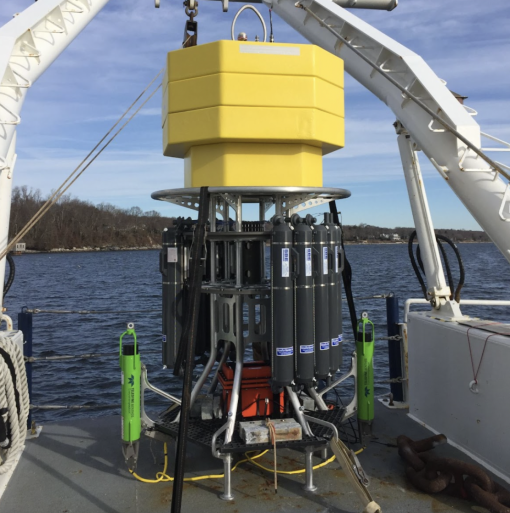
As always the case with OET expeditions, community outreach is a key part of this expedition’s goals. Audiences in Hawaiʻi and worldwide can join the expedition team learning about these offshore underwater mountains via NautilusLive.org, which provides 24-7 live-streaming, interactive events for schools, deep-sea highlight videos, and educational content.
Using the excitement of discovery, OET aims to create an ocean-literate society with workforce development, STEAM education programs, and public outreach, specifically focusing on engaging historically marginalized groups. This is OET’s seventh expedition of 2023 and 155th worldwide with the mission to advance scientific knowledge, inform future exploration efforts, and engage a new generation of curious minds eager to learn more about our fascinating underwater world.
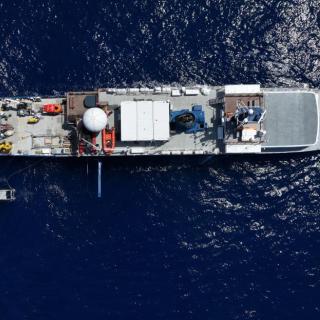
OECI Multi-vehicle Exploration
Over the last three years OET has been working with partners from Ocean Exploration Cooperative Institute (OECI) to integrate emerging exploration technologies to enhance ocean exploration.
